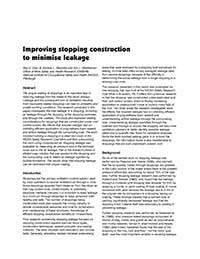Mining Publication: Improving stopping construction to minimise leakage
Original creation date: July 2012
Authors: RH Grau, A Mazzella, AL Martikainen
NIOSHTIC2 Number: 20041942
J Mine Vent Soc S Afr 2012 Jul/Sep; 65(3):16-21
The proper sealing of stoppings is an important step in reducing leakage from the intake to the return airways. Leakage and the subsequent loss of ventilation resulting from improperly sealed stoppings can lead to unhealthy and unsafe working conditions. The research presented in this paper investigates the total leakage of a stopping, including air leakage through the stopping, at the stopping perimeter, and through the coalbed. The study also examines sealing considerations for stoppings that are constructed under roof control screen, the effects that wooden wedges had on inhibiting efficient application of polyurethane foam sealant, and airflow leakage through the surrounding coal. The work involved building a stopping in a dead end room of the NIOSH Safety Research Coal Mine and then pressurising the room using compressed air. Stopping leakage was evaluated by measuring air pressure loss in the enclosed room due to the air leakage. Part of the research utilises a diluted soap solution that was applied to the stopping and the surrounding coal to detect air leakage signified by bubble formations. The results show that stopping leakage can be minimised with proper sealing.

NIOSHTIC2 Number: 20041942
J Mine Vent Soc S Afr 2012 Jul/Sep; 65(3):16-21
- Clearing the Air
- Comparison of Methods: Dynamic Versus Hydrostatic Testing of Mine Ventilation Seals
- Evaluation of Explosion-Resistant Seals, Stoppings, and Overcast for Ventilation Control in Underground Coal Mining
- Evaluation of Reinforced Cementitious Seals
- Explosion Pressure Design Criteria for New Seals in U.S. Coal Mines
- Inflatable Partitions for High-Expansion Foam Generators
- Mine Roof Simulator (MRS) Laboratory
- Progress Toward Improved Engineering of Seals and Sealed Areas of Coal Mines
- Strength Characteristics and Air-Leakage Determinations for Alternative Mine Seal Designs
- Strengthening Existing 20-psi Mine Ventilation Seals With Carbon Fiber-Reinforced Polymer Reinforcement